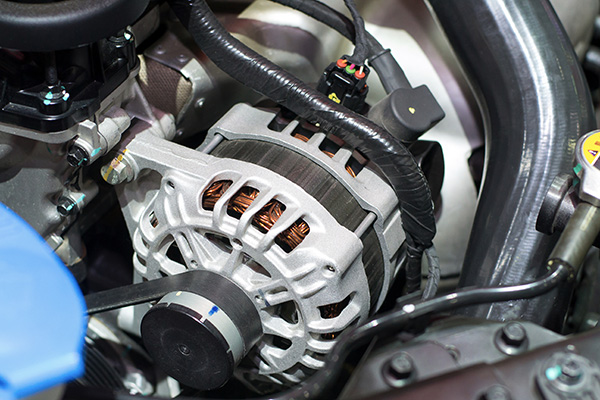
A healthy alternator keeps your battery charged and every electrical system steady while you drive. When it weakens, the symptoms creep in slowly, then pile up all at once. Maybe the lights flicker when you stop at a light, or accessories cut out on a rainy night with the heater and wipers running.
Catching the signs early prevents the inconvenient situation and protects the battery, the starter, and sensitive electronics.
Early Clues Your Alternator Is Struggling
A weak alternator often shows up as dim headlights at idle that brighten when you rev the engine. Power windows move slower than usual, the radio flickers when you turn on the rear defroster, or the blower changes speed on its own. If the car cranks normally in the morning yet needs a jump after a night of short trips with heavy accessory use, the battery may be fine, and the alternator may not be keeping up.
What the Alternator Does During Every Drive
The battery starts the engine, then the alternator takes over. It generates electricity for lights, ignition, fuel pump, and every module, while also recharging the battery. A built in voltage regulator keeps output within a narrow range so electronics see clean power. When a diode fails or the regulator drifts, the output becomes unstable. That instability creates flicker, warning lights, and random glitches that come and go with engine speed.
Battery vs. Alternator: Quick Ways to Tell
A tired battery struggles most at startup, then the car runs normally once the alternator takes over. A weak alternator allows a good battery to discharge while you drive. If jump starting gets you going, then the engine keeps running, but the car dies the next time you shut it off, suspect charging rather than the battery itself. Another tip is charge behavior. If the battery charges fully on a tender overnight, yet is low again after a short commute with lights and A/C on, the alternator likely is not replacing what you used.
Noises and Smells That Point to Charging Trouble
A failing alternator bearing can whine or growl with engine speed. A slipping belt creates a sharp squeal on cold starts or when you switch on heavy loads. If the belt slips long enough, you may notice a hot, rubbery odor near the front of the engine. Some alternators run hot when internal diodes fail, which can add a faint electrical smell after a long drive. Any new noise from the front of the engine while electrical loads are on is worth checking soon.
Dashboard Warnings and Dim Lights Explained
The battery light on your dash monitors charging voltage, not only battery condition. It may glow faintly at idle, then get brighter with accessories on, or it may come and go with bumps if the alternator brushes are worn. Modern vehicles can also display messages about charging system service or set codes that mention low system voltage. If several warning lights appear together, low voltage can confuse multiple modules at once. Treat that cluster of lights as a charging clue, not a dozen unrelated failures.
Simple Checks You Can Do at Home
- Look at the belt. If it looks glazed, cracked, or frayed, replace it and recheck.
- With the engine running, turn on headlights, rear defroster, and blower. If lights dim and the idle changes dramatically, output may be low.
- After a short drive, feel the alternator area carefully. Excess heat, a strong hot smell, or visible arcing at the pulley is not normal.
- If you own a basic multimeter, measure battery voltage. Around 12.6 volts with the engine off is normal for a full battery. With the engine idling, you should see roughly 13.8 to 14.6 volts. Significantly less suggests weak alternator output.
These checks do not replace a full test, yet they help you decide whether to schedule service soon.
Why Prompt Charging System Tests Save Money
Driving on low voltage stresses everything. The fuel pump draws harder, coils work inconsistently, and modules reset at random. The battery is forced to carry the load, which shortens its life. A proper charging system test checks alternator output at idle and at higher rpm, measures ripple that points to diode failure, verifies regulator control, and inspects the belt and tensioner. Fixing a loose belt or a failing regulator now is far cheaper than replacing a battery, a starter, and an alternator after several weeks of strain.
Keep Your Vehicle Charging Right with North Dallas Imports in Garland, TX
North Dallas Imports will test your battery and alternator, inspect the belt and tensioner, and give you a clear plan to fix the problem. Call our Garland shop or book an appointment online so you are not stuck with a dead battery at the worst time.
We will get your charging system back to steady, reliable operation.